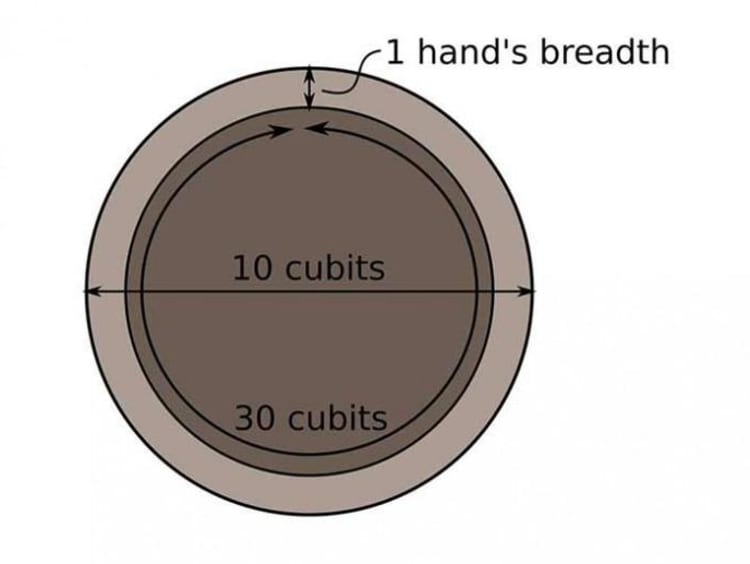Solomon and Pi

Pi is the ratio of a circle’s circumference to its diameter that is commonly stated as 3.14. However, it is an irrational number, meaning that it goes on forever: 3.14159265358979…. Today, aficionados celebrate Pi day every March 14t (3/14) and “epic Pi Day” is this year (3/14/15). Our family will celebrate with pie, pizza pie, recitations of Pi and many friends.
Critics of the Bible sometimes point to 1 Kings 7:23 as evidence that the Bible is untrustworthy. This verse states,
Then he made the sea of cast metal. It was round, ten cubits from brim to brim, and five cubits high, and a line of thirty cubits measured its circumference (ESV).
With a circumference of 30 cubits and a diameter of 10 cubits, Solomon’s ceremonial pool would yield an incorrect calculation of Pi as 3.0, or would it?
One common solution to this problem is pointing to the very round numbers used in this description. With only one significant digit provided, these measurements seem to be rounded to the nearest ten! Therefore, the point of this text is not focused on precision, but on approximation (Patterson & Austell, 1988, p.74). In such an approximation, Pi would also be approximate yet having only a 4.5 percent error. In this understanding, the author of 1 Kings simply wanted history to know that this ceremonial pool was very big and nothing more.
Another solution to the problem, dating back to the Mishnat ha-Middot (c.150AD), points to the thickness of the vessel:
It’s thickness was a handbreadth, and its brim was made like the brim of a cup (1 Ki 7:26a ESV).
A brim is on the outside of a vessel. Since the measurement is brim to brim, it would include the thickness of the ceremonial pool whereas the circumference would be the internal circumference. A cubit is a length from elbow to the tip of the middle finger and a handbreadth, or palm is the distance across the four fingers of the hand. These were normal measures of the ancient Near East, but did vary (Harrison, 1979, p.610). Today, we generally use 17.5 inches as approximately the length of a cubit and three inches for a handbreadth. Using these measures, a new calculation can be created:
30 cubits (internal circumference)/ 10 cubits (brim-to-brim diameter) – 2 handbreadths (for each rim)/ = Pi
30 x 17.5 inches/10 x 17.5 inches – 2 x 3 inches = Pi
525/169 inches = 3.11
This calculation has less than a 1 percent error, which may be due to the varying lengths of cubits and handbreadths, the ceremonial pool being less than perfectly round or rounding.
Whichever solution seems best, the Bible has shown itself trustworthy historically and most importantly, theologically.
Resources:
Harrison, R. (1979). Cubit. In (Ed.), International Standard Bible Encyclopedia, (Vol.1, pp.832-833). Grand Rapids, MI: Eerdmans.
Patterson D. & Austell, H. (1988). 1 & 2 Kings. In F. Gaebelein (Ed.), Expositors Bible Commentary, (Vol 4, pp.1-300). Grand Rapids, MI: Zondervan.
The views and opinions expressed in this article are those of the author’s and do not necessarily reflect the official policy or position of Grand Canyon University. Any sources cited were accurate as of the publish date.


